Advertisements
Advertisements
प्रश्न
Read the following paragraph and answer the questions.
| A capacitor is a system of two conductors separated by an insulator. The two conductors have equal and opposite charges with a potential difference between them. The capacitance of a capacitor depends on the geometrical configuration (shape, size and separation) of the system and also on the nature of the insulator separating the two conductors. They are used to store charges. Like resistors, capacitors can be arranged in series or parallel or a combination of both to obtain the desired value of capacitance. |
- Find the equivalent capacitance between points A and B in the given diagram.

- A dielectric slab is inserted between the plates of the parallel plate capacitor. The electric field between the plates decreases. Explain.
- A capacitor A of capacitance C, having charge Q is connected across another uncharged capacitor B of capacitance 2C. Find an expression for (a) the potential difference across the combination and (b) the charge lost by capacitor A.
OR
Two slabs of dielectric constants 2K and K fill the space between the plates of a parallel plate capacitor of plate area A and plate separation d as shown in the figure. Find an expression for the capacitance of the system.
उत्तर
- The given circuit can be redrawn as it is a balanced Wheatstone bridge.
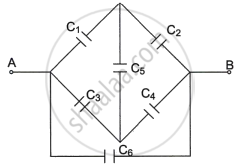
i.e., `C_1/C_2 = C_3/C_4 = C/C = 1/1`
So, Cs can be neglected.
So, the equivalent capacitance between A and B,
`C_{eq} = ((1 xx 1)/(1 + 1) + (1 xx 1)/(1 + 1) + 1)C = 2C` - Total charge of the capacitor remains conserved on the introduction of a dielectric slab. Also, the capacitance of the capacitor increases to K time of its original value.
∴ CV = C'V = KC.V (since Q = Q')
⇒ `V = V/K`
Now electric field,
`E = V/d = ((V"/"K))/d`
= `(V/d)(1/K) = E/K`
So, on introducing a dielectric medium.
The electric field reduces by `(1/K)` times its original value. - (a) The initial charge on capacitor Q = CV.
This capacitor gets connected to another parallel. So total capacitance will be
C' = C + 2C = 3C
The potential difference across this combination will be VC·
`V_C = Q/C^' = Q/(3C)`
As both the capacitors are connected in parallel, therefore, the voltage of both will be the same.
(b) Charges on both capacitors,
`Q_A = CV_C = C. Q/(3C) = Q/3`
`Q_B = 2CV_C = 2C. Q/(3C) = 2/3Q`
∴ Charge lost by capacitor A = `1/3Q`
OR
The effective capacitance in series,
C = `(Kepsi_0A)/d`
C = `(C_1C_2)/(C_1 + C_2)`
`C_1 = (2Kepsi_0A)/(d"/"3), C_2 = (Kepsi_0A)/(2d"/"3)`
C = `(C_1C_2)/(C_1 + C_2)`
= `(((2Kepsi_0A xx 3)/d) ((3Kepsi_0A)/(2d)))/((Kepsi_0A)/d(6 + 3/2))`
= `(9Kepsi_0A xx 2)/(15d)`
= `(6Kepsi_0A)/(5d)`
APPEARS IN
संबंधित प्रश्न
A capacitor of capacitance ‘C’ is charged to ‘V’ volts by a battery. After some time the battery is disconnected and the distance between the plates is doubled. Now a slab of dielectric constant, 1 < k < 2, is introduced to fill the space between the plates. How will the following be affected? (a) The electric field between the plates of the capacitor Justify your answer by writing the necessary expressions.
(i) Find equivalent capacitance between A and B in the combination given below. Each capacitor is of 2 µF capacitance.

(ii) If a dc source of 7 V is connected across AB, how much charge is drawn from the source and what is the energy stored in the network?
Two capacitors each having capacitance C and breakdown voltage V are joined in series. The capacitance and the breakdown voltage of the combination will be
Following operations can be performed on a capacitor:
X − connect the capacitor to a battery of emf ε.
Y − disconnect the battery.
Z − reconnect the battery with polarity reversed.
W − insert a dielectric slab in the capacitor.
(a) In XYZ (perform X, then Y, then Z) the stored electric energy remains unchanged and no thermal energy is developed.
(b) The charge appearing on the capacitor is greater after the action XWY than after the action XYZ.
(c) The electric energy stored in the capacitor is greater after the action WXY than after the action XYW.
(d) The electric field in the capacitor after the action XW is the same as that after WX.
A cylindrical capacitor is constructed using two coaxial cylinders of the same length 10 cm and of radii 2 mm and 4 mm. (a) Calculate the capacitance. (b) Another capacitor of the same length is constructed with cylinders of radii 4 mm and 8 mm. Calculate the capacitance.
Find the equivalent capacitances of the combinations shown in figure between the indicated points.
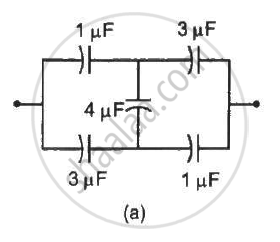

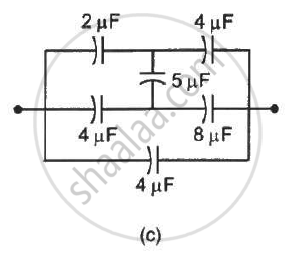
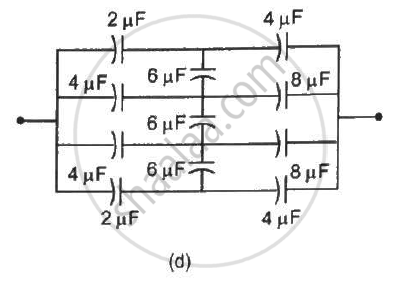
A capacitor of capacitance 2⋅0 µF is charged to a potential difference of 12 V. It is then connected to an uncharged capacitor of capacitance 4⋅0 µF as shown in figure . Find (a) the charge on each of the two capacitors after the connection, (b) the electrostatic energy stored in each of the two capacitors and (c) the heat produced during the charge transfer from one capacitor to the other.
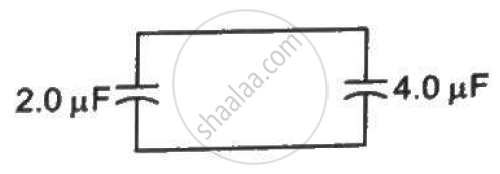
Consider the situation shown in figure. The plates of the capacitor have plate area A and are clamped in the laboratory. The dielectric slab is released from rest with a length a inside the capacitor. Neglecting any effect of friction or gravity, show that the slab will execute periodic motion and find its time period.
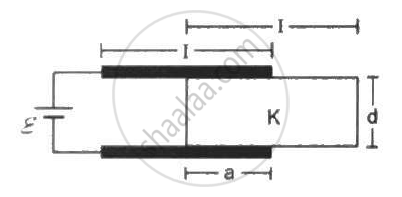
Derive the expression for resultant capacitance, when the capacitor is connected in series.
The capacitance of a parallel plate capacitor is 60 µF. If the distance between the plates is tripled and area doubled then new capacitance will be ______.
